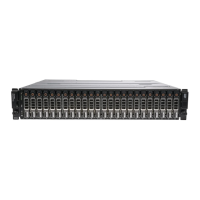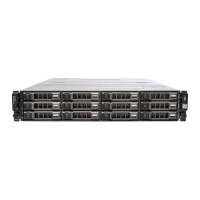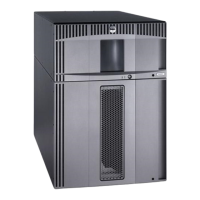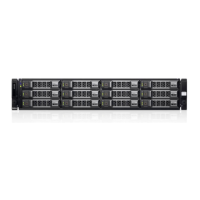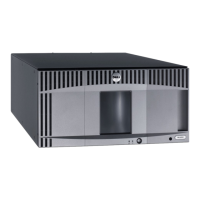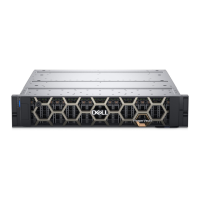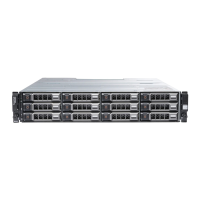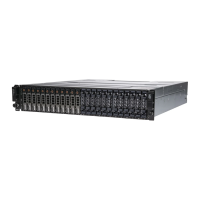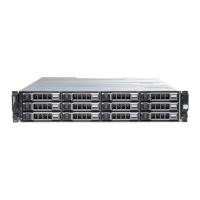Do you have a question about the Dell PowerVault MD Series and is the answer not in the manual?
GUI application for configuring and managing MD Series storage arrays.
Describes the two primary windows of the Storage Manager: EMW and AMW.
Imports operating system theme settings into MD Storage Manager for font, color, and contrast.
iSCSI Configuration Wizard to simplify iSCSI connection setup with MD Storage Manager.
Explains storage concepts: physical disks, virtual disks, and disk groups for data organization.
Allows data distribution across physical disks, providing RAID protection and consistent performance.
Explains thin provisioning, its advantages, requirements, and limitations for flexible capacity management.
Details different RAID levels for data striping, mirroring, and parity for performance and redundancy.
Covers essential operations like initialization, consistency checks, and media verification for virtual disks.
Covers operations for managing disk groups, including RAID level and segment size migration.
Defines how host servers access virtual disks through host ports and establishes mappings.
Introduces advanced features like snapshots, virtual disk copy, and remote replication.
Manages storage arrays via separate management Ethernet ports, isolating data and control traffic.
Manages storage arrays via the host-to-controller interface, mixing commands, events, and data.
Outlines initial tasks for setting up a storage array, including naming, password, and configuration.
Details how to configure a password for a storage array to protect it from unauthorized access.
Configures system alerts via email or SNMP for storage array events and conditions.
Configures iSCSI target authentication methods, including CHAP and mutual authentication.
Configures network settings for iSCSI host ports, including IPv4, IPv6, VLAN, and priority.
Allows monitoring and termination of active iSCSI sessions for security or system downtime.
Manages the event monitor service to receive notifications for critical problems or events.
Sets up access for hosts to virtual disks by defining hosts, host groups, and mappings.
Organizes hosts into logical groups to share access to virtual disks, simplifying management.
Describes the organization of hosts, groups, and interfaces for a storage array.
Covers the process of organizing physical disks into groups and creating virtual disks for data.
Provides guidelines and steps for creating standard virtual disks from free capacity or disk pools.
Explains thin provisioning, its advantages, requirements, and limitations for flexible capacity management.
Details SED technology, security keys, and securing disk groups against unauthorized access.
Compares disk pools and disk groups regarding data distribution and RAID level application.
Lists limitations for disk pools, including media type, segment size, and export/import constraints.
Guides users through manually creating a disk pool using unconfigured capacity in a storage array.
Covers creating secure disk pools using SED disks and managing their security status.
Explains how SSD cache improves read performance, application throughput, and response times.
Provides steps for creating an SSD cache, selecting I/O types, data assurance, and capacity.
Manages SSD caching operations by suspending or resuming the caching process.
Compares Snapshot Virtual Disk (PiT groups) with the Legacy version regarding repositories and features.
Introduces snapshot groups and consistency groups for managing point-in-time data copies.
Details how to create point-in-time images of virtual disks for data backup and recovery.
Explains how to restore virtual disks to a previous point-in-time state using snapshot images.
Guides the creation of snapshot groups to manage sequences of point-in-time images.
Allows scheduling of snapshot virtual disk creation for automated backups and recovery.
Guides creation using a straightforward method when sufficient free space is available.
Provides detailed options for creating snapshots, including repository placement and parameters.
Explains how to increase or manage the capacity of snapshot repository virtual disks.
Details the process of re-creating previously disabled snapshot virtual disks.
Describes offline and online methods for copying virtual disk data to another virtual disk.
Lists critical restrictions for source, target, and storage array when performing virtual disk copies.
Step-by-step process for creating a virtual disk copy, including using the Create Copy Wizard.
Allows adjustment of copy priority to balance I/O performance and copy completion time.
Provides procedures to stop a virtual disk copy operation that is in progress, pending, or failed.
Outlines the sequence of steps for configuring DM multipathing and making storage available to Linux.
Provides recommended procedures for rebooting Linux hosts using DM multipathing with MD Series storage.
Lists important constraints and known issues related to Device Mapper multipathing.
Offers solutions to common problems encountered with Device Mapper multipathing.
Discusses performance implications when using ALUA with dual-controller configurations.
Details manual steps to enable ALUA on VMware ESX/ESXi by adding SATP claim rules.
Configures round-robin load balancing for ESX/ESXi hosts after enabling ALUA.
Explains asynchronous replication for data replication between local and remote storage arrays.
Lists prerequisites and limitations for setting up and using standard Remote Replication.
Covers the process of setting up remote replication, including activation and group creation.
Guides the creation of a group to manage replication pairs, synchronizing data sets across arrays.
Details the steps to create replicated pairs of virtual disks and place them in a replication group.
Explains how to break replication relationships and revert disks to standard status.
Introduces the legacy feature for real-time synchronous replication over Fibre Channel.
Guides the activation of the legacy remote replication feature and creation of repository virtual disks.
Explains how legacy remote replication interacts with storage partitioning and snapshot/virtual disk copy features.
Provides guidelines for configuring Fibre Channel switch zoning for legacy remote replication.
Describes downloading and activating firmware and NVSRAM packages for RAID controllers.
Details the process of downloading firmware to physical disks to control their features.
Covers downloading EMM firmware for expansion modules, emphasizing out-of-band management.
Explains SMART monitoring for detecting potential physical disk failures and reporting them.
Describes how to view and save firmware versions for all components in the storage array.
Explains the Microsoft Virtual Disk Service component and its role in managing storage arrays.
Describes the VSS component and its use with MD Series storage for snapshot and disk copy functionality.
Lists indications to observe during the array's start-up routine for status checks.
Explains how to interpret status icons (Optimal, Needs Attention, Fixing) for storage arrays and components.
Provides information on how to contact Dell for online and telephone-based support and service options.
GUI application for configuring and managing MD Series storage arrays.
Describes the two primary windows of the Storage Manager: EMW and AMW.
Imports operating system theme settings into MD Storage Manager for font, color, and contrast.
iSCSI Configuration Wizard to simplify iSCSI connection setup with MD Storage Manager.
Explains storage concepts: physical disks, virtual disks, and disk groups for data organization.
Allows data distribution across physical disks, providing RAID protection and consistent performance.
Explains thin provisioning, its advantages, requirements, and limitations for flexible capacity management.
Details different RAID levels for data striping, mirroring, and parity for performance and redundancy.
Covers essential operations like initialization, consistency checks, and media verification for virtual disks.
Covers operations for managing disk groups, including RAID level and segment size migration.
Defines how host servers access virtual disks through host ports and establishes mappings.
Introduces advanced features like snapshots, virtual disk copy, and remote replication.
Manages storage arrays via separate management Ethernet ports, isolating data and control traffic.
Manages storage arrays via the host-to-controller interface, mixing commands, events, and data.
Outlines initial tasks for setting up a storage array, including naming, password, and configuration.
Details how to configure a password for a storage array to protect it from unauthorized access.
Configures system alerts via email or SNMP for storage array events and conditions.
Configures iSCSI target authentication methods, including CHAP and mutual authentication.
Configures network settings for iSCSI host ports, including IPv4, IPv6, VLAN, and priority.
Allows monitoring and termination of active iSCSI sessions for security or system downtime.
Manages the event monitor service to receive notifications for critical problems or events.
Sets up access for hosts to virtual disks by defining hosts, host groups, and mappings.
Organizes hosts into logical groups to share access to virtual disks, simplifying management.
Describes the organization of hosts, groups, and interfaces for a storage array.
Covers the process of organizing physical disks into groups and creating virtual disks for data.
Provides guidelines and steps for creating standard virtual disks from free capacity or disk pools.
Explains thin provisioning, its advantages, requirements, and limitations for flexible capacity management.
Details SED technology, security keys, and securing disk groups against unauthorized access.
Compares disk pools and disk groups regarding data distribution and RAID level application.
Lists limitations for disk pools, including media type, segment size, and export/import constraints.
Guides users through manually creating a disk pool using unconfigured capacity in a storage array.
Covers creating secure disk pools using SED disks and managing their security status.
Explains how SSD cache improves read performance, application throughput, and response times.
Provides steps for creating an SSD cache, selecting I/O types, data assurance, and capacity.
Manages SSD caching operations by suspending or resuming the caching process.
Compares Snapshot Virtual Disk (PiT groups) with the Legacy version regarding repositories and features.
Introduces snapshot groups and consistency groups for managing point-in-time data copies.
Details how to create point-in-time images of virtual disks for data backup and recovery.
Explains how to restore virtual disks to a previous point-in-time state using snapshot images.
Guides the creation of snapshot groups to manage sequences of point-in-time images.
Allows scheduling of snapshot virtual disk creation for automated backups and recovery.
Guides creation using a straightforward method when sufficient free space is available.
Provides detailed options for creating snapshots, including repository placement and parameters.
Explains how to increase or manage the capacity of snapshot repository virtual disks.
Details the process of re-creating previously disabled snapshot virtual disks.
Describes offline and online methods for copying virtual disk data to another virtual disk.
Lists critical restrictions for source, target, and storage array when performing virtual disk copies.
Step-by-step process for creating a virtual disk copy, including using the Create Copy Wizard.
Allows adjustment of copy priority to balance I/O performance and copy completion time.
Provides procedures to stop a virtual disk copy operation that is in progress, pending, or failed.
Outlines the sequence of steps for configuring DM multipathing and making storage available to Linux.
Provides recommended procedures for rebooting Linux hosts using DM multipathing with MD Series storage.
Lists important constraints and known issues related to Device Mapper multipathing.
Offers solutions to common problems encountered with Device Mapper multipathing.
Discusses performance implications when using ALUA with dual-controller configurations.
Details manual steps to enable ALUA on VMware ESX/ESXi by adding SATP claim rules.
Configures round-robin load balancing for ESX/ESXi hosts after enabling ALUA.
Explains asynchronous replication for data replication between local and remote storage arrays.
Lists prerequisites and limitations for setting up and using standard Remote Replication.
Covers the process of setting up remote replication, including activation and group creation.
Guides the creation of a group to manage replication pairs, synchronizing data sets across arrays.
Details the steps to create replicated pairs of virtual disks and place them in a replication group.
Explains how to break replication relationships and revert disks to standard status.
Introduces the legacy feature for real-time synchronous replication over Fibre Channel.
Guides the activation of the legacy remote replication feature and creation of repository virtual disks.
Explains how legacy remote replication interacts with storage partitioning and snapshot/virtual disk copy features.
Provides guidelines for configuring Fibre Channel switch zoning for legacy remote replication.
Describes downloading and activating firmware and NVSRAM packages for RAID controllers.
Details the process of downloading firmware to physical disks to control their features.
Covers downloading EMM firmware for expansion modules, emphasizing out-of-band management.
Explains SMART monitoring for detecting potential physical disk failures and reporting them.
Describes how to view and save firmware versions for all components in the storage array.
Explains the Microsoft Virtual Disk Service component and its role in managing storage arrays.
Describes the VSS component and its use with MD Series storage for snapshot and disk copy functionality.
Lists indications to observe during the array's start-up routine for status checks.
Explains how to interpret status icons (Optimal, Needs Attention, Fixing) for storage arrays and components.
Provides information on how to contact Dell for online and telephone-based support and service options.
| Product Line | PowerVault MD Series |
|---|---|
| Category | Storage |
| Drive Interface | SAS, SSD |
| Form Factor | 2.5-inch, 3.5-inch |
| RAID Levels | 0, 1, 5, 6, 10, 50, 60 (depending on the controller and model) |
| Connectivity | SAS |
| Drive Types Supported | SSD |
| Host Connectivity | SAS, iSCSI, Fibre Channel (depending on model) |
| Management Software | Dell Storage Manager |

